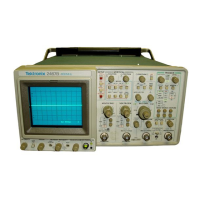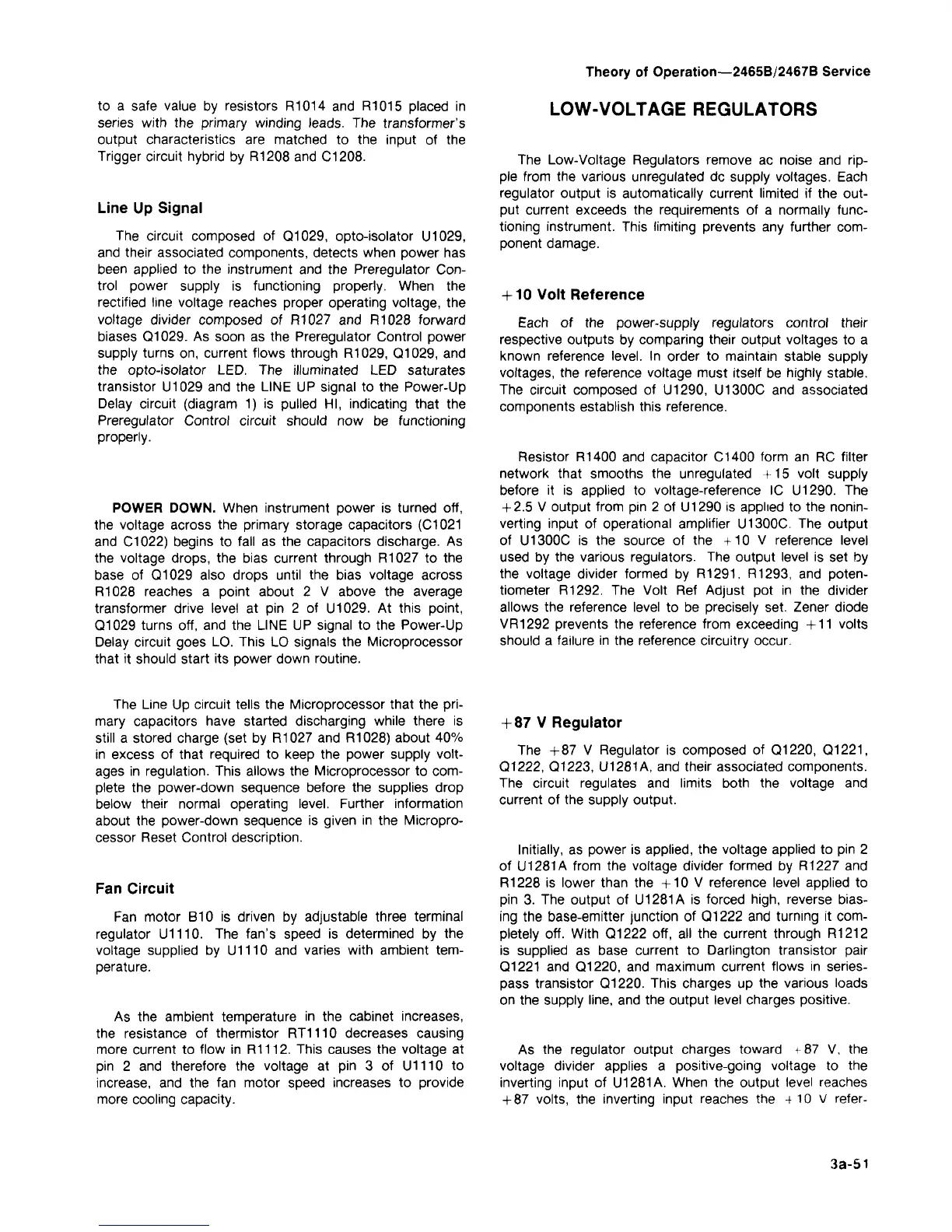to a safe value by resistors R1014 and R1015 placed in
series with the primary winding leads. The transformer's
output characteristics are matched to the input of the
Trigger circuit hybrid by R1208 and C1208.
Line Up Signal
The circuit composed of Q1029, opto-isolator U1029,
and their associated components, detects when power has
been applied to the instrument and the Preregulator
Con-
trol power supply is functioning properly. When the
rectified line voltage reaches proper operating voltage, the
voltage divider composed of R1027 and R1028 forward
biases Q1029. As soon as the Preregulator Control power
supply turns on, current flows through R1029, Q1029, and
the opto-isolator LED. The illuminated LED saturates
transistor U1029 and the LINE UP signal to the Power-Up
Delay circuit (diagram 1) is pulled HI, indicating that the
Preregulator Control circuit should now be functioning
properly.
POWER DOWN. When instrument power is turned off,
the voltage across the primary storage capacitors (C1021
and C1022) begins to fall as the capacitors discharge. As
the voltage drops, the bias current through R1027 to the
base of Q1029 also drops until the bias voltage across
R1028 reaches a point about 2 V above the average
transformer drive level at pin 2 of U1029. At this point,
Q1029 turns off, and the LINE UP signal to the Power-Up
Delay circuit goes LO. This LO signals the Microprocessor
that it should start its power down routine.
The Line Up circuit tells the Microprocessor that the
pri-
mary capacitors have started discharging while there is
still a stored charge (set by R1027 and R1028) about 40%
in excess of that required to keep the power supply volt-
ages in regulation. This allows the Microprocessor to com-
plete the power-down sequence before the supplies drop
below their normal operating level. Further information
about the power-down sequence is given in the Micropro-
cessor Reset Control description.
Fan Circuit
Fan motor B10 is driven by adjustable three terminal
regulator U1110. The fan's speed is determined by the
voltage supplied by U1110 and varies with ambient
tem-
perature.
As the ambient temperature in the cabinet increases,
the resistance of thermistor RT1110 decreases causing
more current to flow in R1112. This causes the voltage at
pin 2 and therefore the voltage at pin 3 of U1110 to
increase, and the fan motor speed increases to provide
more cooling capacity.
Theory of Operation—2465B/2467B Service
LOW-VOLTAGE REGULATORS
The Low-Voltage Regulators remove ac noise and
rip-
ple from the various unregulated dc supply voltages. Each
regulator output is automatically current limited if the out-
put current exceeds the requirements of a normally func-
tioning instrument. This limiting prevents any further com-
ponent damage.
+ 10 Volt Reference
Each of the power-supply regulators control their
respective outputs by comparing their output voltages to a
known reference level. In order to maintain stable supply
voltages, the reference voltage must itself be highly stable.
The circuit composed of U1290, U1300C and associated
components establish this reference.
Resistor R1400 and capacitor C1400 form an RC filter
network that smooths the unregulated +15 volt supply
before it is applied to voltage-reference IC U1290. The
+ 2.5 V output from pin 2 of U1290 is applied to the nonin-
verting input of operational amplifier U1300C. The output
of U1300C is the source of the +10 V reference level
used by the various regulators. The output level is set by
the voltage divider formed by
R1291.
R1293, and poten-
tiometer R1292. The Volt Ref Adjust pot in the divider
allows the reference level to be precisely set. Zener diode
VR1292 prevents the reference from exceeding +11 volts
should a failure in the reference circuitry occur.
+ 87 V Regulator
The +87 V Regulator is composed of Q1220,
Q1221,
Q1222,
Q1223, U1281A, and their associated components.
The circuit regulates and limits both the voltage and
current of the supply output.
Initially, as power is applied, the voltage applied to pin 2
of U1281A from the voltage divider formed by R1227 and
R1228 is lower than the +10 V reference level applied to
pin 3. The output of U1281A is forced
high,
reverse bias-
ing the base-emitter junction of Q1222 and turning it com-
pletely off. With Q1222 off, all the current through R1212
is supplied as base current to Darlington transistor pair
Q1221 and Q1220, and maximum current flows in series-
pass transistor Q1220. This charges up the various loads
on the supply line, and the output level charges positive.
As the regulator output charges toward +87 V, the
voltage divider applies a positive-going voltage to the
inverting input of U1281A. When the output level reaches
+
87
volts, the inverting input reaches the 4 10 V refer-
3a-5l

